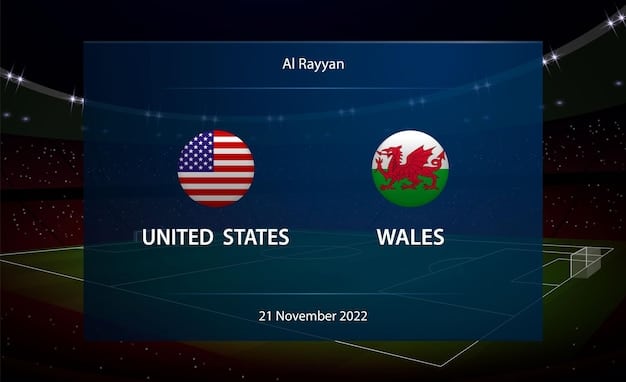FIFA 25 Career Mode: The Ultimate Guide to US Youth Academy Scouting

FIFA 25 Career Mode’s Youth Academy scouting in the US offers a unique opportunity to discover and develop young talents, offering a strategic advantage in building a successful team with home-grown players.
Ready to dominate FIFA 25 Career Mode? One of the most rewarding aspects is building your team through the Youth Academy. This guide focuses specifically on FIFA 25 Career Mode: The Ultimate Guide to Youth Academy Scouting in the US, helping you unearth the next generation of American soccer stars.
Unlocking the Potential of US Youth Academies in FIFA 25
The United States has become a hotbed for soccer talent, and FIFA 25 reflects this. Scouting in the US offers a diverse pool of players with varying skill sets and potential. Understanding how to effectively scout and develop these players is key to long-term success in Career Mode.
So, why focus on US youth academies? Let’s delve into the advantages and strategies you’ll need to succeed.
The Benefits of Scouting in the USA
Scouting in the US offers several advantages over other regions. Here’s why you should consider focusing your efforts stateside:
- Hidden Gems: The US youth system is still developing, meaning there are often undervalued players with high potential waiting to be discovered.
- Diverse Skillsets: The US player pool is increasingly diverse, offering players with a range of technical skills, athleticism, and tactical awareness.
- Homegrown Talent: Developing US players allows you to fulfill homegrown player requirements, often necessary for league regulations.

Setting Up Your Scouting Network
Before you start finding the next Christian Pulisic, you need to set up your scouting network effectively. Here are the key steps:
- Hire Experienced Scouts: Invest in scouts with high judging potential and judging experience ratings. These attributes determine their ability to identify promising players accurately.
- Instruct Your Scouts: Clearly define your scouting instructions. Focus on specific positions, age ranges (e.g., 15-18), and desired player attributes (e.g., technically gifted, physically strong).
- Assign Scouts to the US: Send your best scouts to the United States. Consider dividing the country into regions to maximize coverage.
By setting up a robust scouting network, you’ll increase your chances of finding top-tier talent in the US youth academies. Remember that patience and persistence are key; it may take time to uncover the best players.
Identifying Key Player Attributes for US Prospects
Knowing what to look for in a young player is crucial. Not all potential is created equal. Different positions require different attributes, and understanding these nuances can help you identify players who will truly excel in your team.
So, what are the key attributes to consider when scouting US youth prospects?
Technical Skills
Technical skills are fundamental to any soccer player, but certain attributes are more important for specific positions. For example:
Passing and Vision: Essential for midfielders and playmaking forwards. Look for players with high ratings in short passing, long passing, vision, and crossing.
Dribbling and Ball Control: Crucial for wingers and attacking midfielders. Focus on players with high ratings in dribbling, ball control, agility, and balance.
Physical Attributes
Physical attributes can make or break a player, especially in the demanding world of professional soccer. Key attributes to consider include:
Pace and Acceleration: Vital for attackers and wingers. Look for players with high ratings in sprint speed and acceleration.
Stamina and Strength: Important for all positions, but particularly for midfielders and defenders. Focus on players with high ratings in stamina, strength, and aggression.
Mental Attributes
Mental attributes are often overlooked, but they are just as important as technical and physical skills. Key mental attributes include:
- Aggression: This is very important for defenders to win back balls.
- Vision: A player’s ability to see the field and make smart decisions.
- Composure: The ability to perform under pressure. Look for players with high ratings in composure, reactions, and positioning.

Remember to consider the player’s overall potential rating as well. While attributes are important, a high potential rating indicates that the player has the capacity to develop into a world-class talent. By carefully evaluating these key attributes, you can identify US youth prospects who have the potential to become stars in your FIFA 25 Career Mode.
Navigating the US Soccer Landscape in FIFA 25
The US soccer landscape is unique, with a mix of professional and amateur leagues, youth academies, and development programs. Understanding this landscape can help you target the most promising prospects and maximize your scouting efforts.
So, how can you navigate this complex landscape effectively?
Major League Soccer (MLS) Academies
MLS academies are a prime source of talent in the US. These academies are affiliated with MLS clubs and provide a structured development pathway for young players. Scouting MLS academies can yield high-potential players who are already familiar with professional training environments.
Development Academy Clubs
Outside of MLS academies, there are numerous development academy clubs across the US. These clubs focus on player development and often produce talented players who go on to play professionally or collegiately. Scouting these clubs can uncover hidden gems who may not be on the radar of MLS academies.
College Soccer Programs
College soccer is another important pathway for player development in the US. Many talented players choose to play college soccer before turning professional. Scouting college programs can identify players who have gained valuable experience and are ready to make the jump to professional soccer.
By scouting these various leagues and programs, you can tap into a diverse pool of talent and find players who fit your team’s needs and playing style. Remember that patience and persistence are key; it may take time to find the right players.
Focusing your scouting efforts on specific regions known for producing talent can also be beneficial. For example, California, Texas, and Florida are known for their vibrant youth soccer scenes.
Training and Development Strategies for US Youth Players
Once you’ve scouted and signed a promising US youth player, the real work begins: training and development. Nurturing young talent requires a strategic approach that focuses on developing their technical skills, physical attributes, and mental fortitude.
How can you effectively train and develop your US youth players in FIFA 25?
Custom Training Drills
FIFA 25 offers a range of custom training drills that allow you to target specific player attributes. Focus on drills that address the player’s weaknesses and enhance their strengths. For example, if a player needs to improve their finishing, focus on shooting drills. If they need to improve their passing, focus on passing drills.
Loan System
The loan system can be a valuable tool for developing young players. Loaning out players to clubs where they will get regular playing time can help them gain experience and improve their overall rating. Focus on loaning players to clubs in leagues that match their playing style and level of competition.
Playing Time and Rotation
Giving young players regular playing time is essential for their development. Rotate them into the starting lineup or bring them on as substitutes to give them opportunities to showcase their skills and gain confidence. Be patient, as it may take time for them to adjust to the demands of professional soccer.
Monitoring their progress regularly and adjusting your training and development strategies as needed is also important. Provide feedback and encouragement to keep them motivated and focused on their goals.
Negotiating Contracts and Managing Expectations
Securing the future of your talented US youth players involves more than just training and development. Negotiating contracts and managing expectations are crucial aspects of long-term success.
So, how can you effectively negotiate contracts and manage the expectations of your US youth players?
Contract Negotiations
When negotiating contracts with young players, consider their potential, current rating, and market value. Offer contracts that are fair and competitive, but also within your club’s budget. Be willing to negotiate on salary, release clauses, and other terms to secure their long-term commitment.
Managing Expectations
Young players often have high expectations, but it’s important to manage these expectations realistically. Communicate openly and honestly about their development progress, playing time opportunities, and future role in the team. Providing mentorship and guidance can help them stay grounded and focused on their goals.
Building Relationships
Building strong relationships with your youth players is key to fostering a positive and supportive environment. Get to know them personally, understand their motivations, and provide encouragement and support. A strong relationship can help them stay committed to your club and reach their full potential.
Recognizing their achievements and providing opportunities for recognition is also important. Feature them in team announcements, highlight their accomplishments on social media, and reward them with bonuses for outstanding performances. By effectively negotiating contracts and managing expectations, you can secure the future of your talented US youth players and build a successful team for years to come.
Troubleshooting Common Scouting Challenges in the US
Even with the best scouting network and development strategies, you may encounter challenges when scouting in the US. Geographical distances, competition from other clubs, and the unpredictable nature of youth development can all pose obstacles.
How can you troubleshoot these common scouting challenges and maximize your success?
Geographical Challenges
The US is a vast country, and scouting across different regions can be challenging and time-consuming. To overcome this challenge, consider dividing the country into regions and assigning scouts to specific areas. Utilize scouting reports, video analysis, and networking to identify promising players in remote locations.
Competition from Other Clubs
The competition for talented youth players is fierce, both domestically and internationally. To stand out from the crowd, offer attractive contract terms, provide clear development pathways, and showcase your club’s commitment to youth development. Building relationships with player agents and youth coaches can also give you a competitive edge.
Unpredictable Youth Development
Youth development is not always linear, and players may experience setbacks or plateau in their progress. To mitigate this risk, have realistic expectations, provide ongoing support and mentorship, and be prepared to adjust your development strategies as needed. Focus on creating a positive and supportive environment that encourages growth and resilience.
Learning from your mistakes and refining your scouting and development processes over time is also important. Track your successes and failures, analyze your data, and make adjustments to improve your overall effectiveness. By troubleshooting these common scouting challenges, you can increase your chances of finding and developing top-tier US youth players in FIFA 25 Career Mode.
| Key Point | Brief Description |
|---|---|
| ⭐ Scouting Network | Employ experienced scouts and strategically assign them to cover key US regions. |
| ⚽ Key Attributes | Focus on technical, physical, and mental attributes specific to the player’s position. |
| 🌱 Training | Use custom drills and the loan system to enhance player’s skills and experience. |
| 🤝 Contracts | Negotiate fair contracts and manage expectations to secure long-term commitments. |
FAQ
For defenders, prioritize tackling, marking, strength, and aggression. A good pace is also desirable to keep up with fast attackers. Don’t overlook their agility and reactions for making quick interceptions.
Ideally, have scouts permanently stationed in the US. Rotate them every few months or annually to freshen their perspective and prevent them from missing developing talent due to bias.
Yes, absolutely! MLS Next Pro offers invaluable insights into real-time player development. Regular scouting provides ongoing progress insights, potentially uncovering breakout stars.
Focus on players aged 15-18. This age range provides a sweet spot where players have enough foundation skills to assess their potential while still having plenty of time to develop.
Yes, dynamic potential greatly affects the development of US Youth Academy players. Strong performances and consistent play can increase their potential, while poor performances may hinder their growth.
Conclusion
Mastering US youth academy scouting in FIFA 25 Career Mode requires a blend of strategic planning, effective scouting, and patient development. By following the tips and strategies outlined in this guide, you’ll be well-equipped to unearth the next generation of American soccer stars and build a dynasty that dominates the competition.





